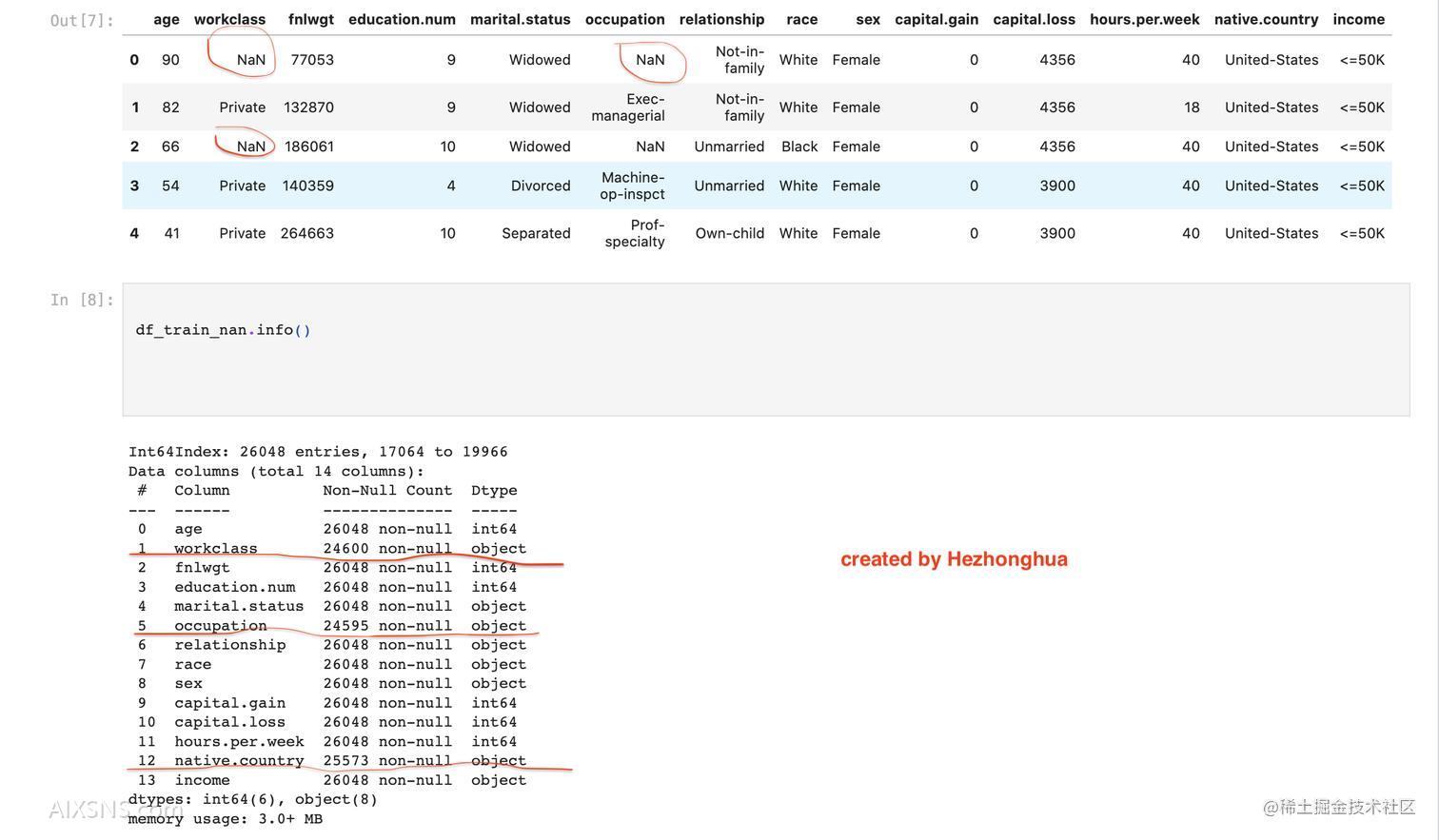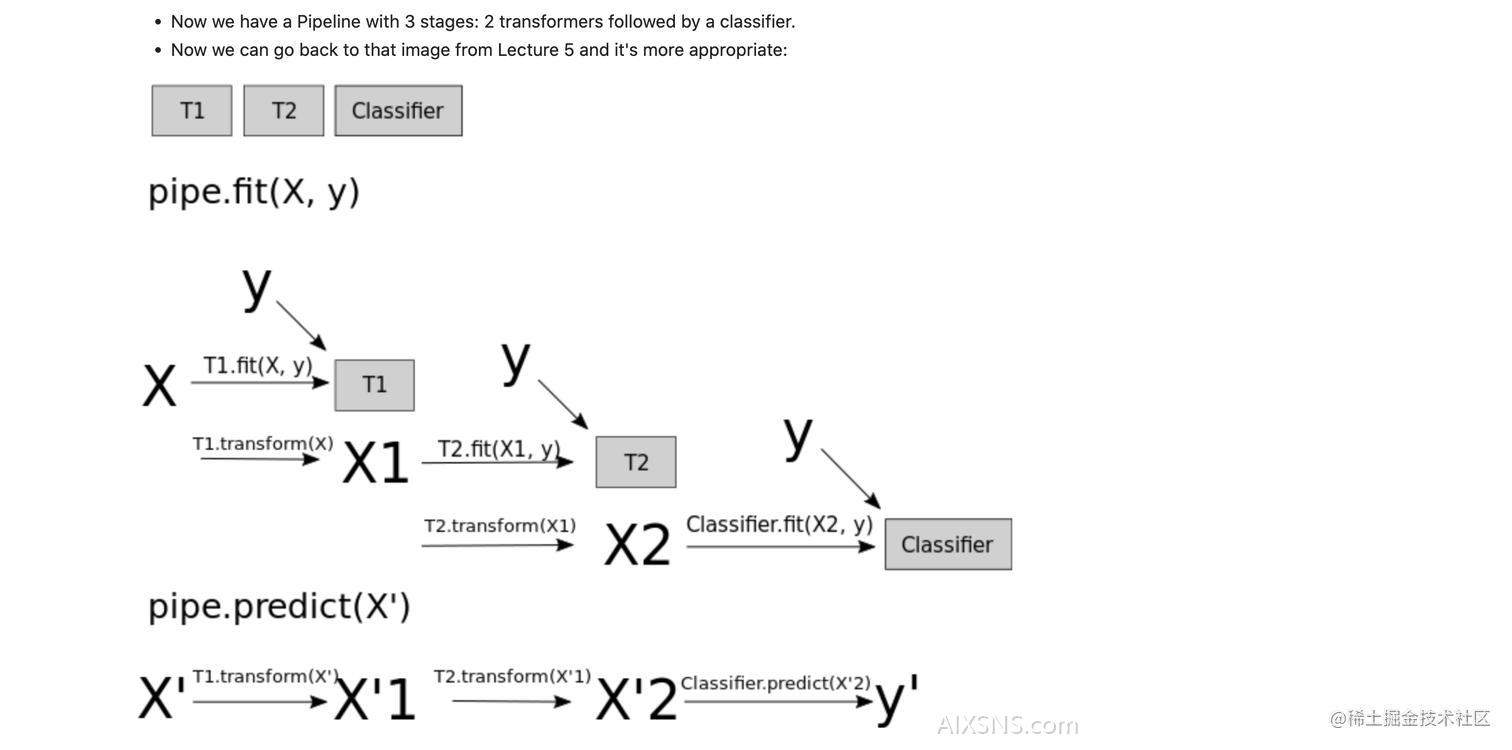本次课程依旧使用人口普查数据, 上次课中,当我们对类别型变量编码的时候,就发现某些列中有?(问号),这是因为此数据集中,当某人在做问卷调查未回答某个问题时,该空缺用?填充(不同数据集用不同符号表示缺失)
因此我们需要面对如何处理缺失值(missing values)的问题,最简单粗暴的办法是某一行如果包含缺失值就丢掉,但此种方法最大的问题是: 如果模型部署后,新来的数据中有缺失值呢? 或者缺失值很多呢,都删掉就会丢掉很多本可以用的数据
所以有必要掌握sklearn中一些处理缺失值的办法,关于该主题如果想深入了解,需去统计学课程中寻找答案
缺失值处理 (简易版)
import pandas as pd
import numpy as np
import matplotlib.pyplot as plt
plt.rcParams['font.size'] = 16
from sklearn.dummy import DummyClassifier
from sklearn.tree import DecisionTreeClassifier
from sklearn.linear_model import LogisticRegression
from sklearn.model_selection import train_test_split, cross_val_score, cross_validate, GridSearchCV, RandomizedSearchCV
from sklearn.preprocessing import OneHotEncoder, OrdinalEncoder
from sklearn.pipeline import Pipeline
from sklearn.preprocessing import StandardScaler, MinMaxScaler
from sklearn.compose import ColumnTransformer
from sklearn import set_config, config_context
census = pd.read_csv('data/adult.csv')
# 上节课提到过可以删除 `education` 列,
# 因为数据集中已经有一列顺序编码过的列 `education.num`.
census = census.drop(columns=["education"])
census_train, census_test = train_test_split(census, test_size=0.2, random_state=123)
# 把代表缺失值的问号,替换为Pandas中标准的 np.NaN
# 这里好像有破坏了 golden rule的嫌疑,对test set进行了操作
# 但我们可以这样理解: 假如原始csv格式的数据中,对缺失值的表示就是标准的,就不需要这一步了,所以说,这里并不算破坏了 golden rule
# 个人理解这一步甚至可以提前到 train_test_split之前,只是为了让同学们养成好习惯,这里放在了之后
df_train_nan = census_train.replace('?', np.NaN)
df_test_nan = census_test.replace( '?', np.NaN)
df_train_nan.sort_index().head()

注意:这里我们处理的是特征列中的缺失值,而不是目标列income中的缺失值,
因为我们做的是监督学习,如果income中有缺失值,那这一行可以考虑删掉
X_train_nan = df_train_nan.drop(columns=['income'])
X_test_nan = df_test_nan.drop(columns=['income'])
y_train = df_train_nan['income']
y_test = df_test_nan['income']
Imputation 插值
- Imputation means inventing values for the missing data.
- The strategies are different for numeric(mean, median…) vs. categorical.
- In this dataset it turns out we only have missing values in the categorical features.
from sklearn.impute import SimpleImputer
imp = SimpleImputer(strategy='most_frequent')
- This imputer is another
transformer, like the other ones we’ve seen (CountVectorizer,OrdinalEncoder,OneHotEncoder).
numeric_features = ['age', 'fnlwgt', 'education.num', 'capital.gain',
'capital.loss', 'hours.per.week']
categorical_features = ['workclass', 'marital.status', 'occupation',
'relationship', 'race', 'sex', 'native.country']
target_column = 'income'
imp.fit(X_train_nan[categorical_features]);
X_train_imp_cat = pd.DataFrame(imp.transform(X_train_nan[categorical_features]),
columns=categorical_features, index=X_train_nan.index)
X_test_imp_cat = pd.DataFrame(imp.transform(X_test_nan[categorical_features]),
columns=categorical_features, index=X_test_nan.index)
X_train_imp = X_train_nan.copy()
X_train_imp.update(X_train_imp_cat)
X_test_imp = X_test_nan.copy()
X_test_imp.update(X_test_imp_cat)
# 至此,所有的缺失值被 most_frequent 策略填充
另一种方法是,人为指定一个固定值插入:
# or just leave in the "?" and have this be its own category for categorical variables.
SimpleImputer(strategy='constant', fill_value="?");
Pipeline
至此,我们可以建立一个3阶段的Pipeline, 先回顾一下Pipeline的执行流程:

pipe = Pipeline([('imputation', SimpleImputer(strategy='most_frequent')),
('ohe', OneHotEncoder(handle_unknown='ignore')),
('lr', LogisticRegression(max_iter=1000))])
pd.DataFrame(cross_validate(pipe, X_train_nan[categorical_features], y_train))

Feature scaling
不同于插值,特征缩放只适用于数值特征
为何要特征缩放
此处以逻辑回归为例,只用数据集中的数值型列来训练模型:
lr = LogisticRegression(max_iter=1000)
pd.DataFrame(cross_validate(lr, X_train_imp[numeric_features], y_train, return_train_score=True))

lr.fit(X_train_imp[numeric_features], y_train);
pd.DataFrame(data=lr.coef_[0], index=numeric_features, columns=['Coefficient'])

可以发现 fnlwgt (final weight)的系数非常小
提问:fnlwgt为何很小呢?我们来一起探究其原因:
X_train_nan.describe()

由统计结果可知,与其他几个数值型列相比,fnlwgt的平均值大约是200,000。我们来回忆逻辑回归,最终会给每个特征训练一个系数,推导时一条数据的每个特征乘以对应的系数,然后相加求和,最后使用sigmoid函数转换到0-1区间,所以说 fnlwgt本身很大,对应的系数就倾向于很小, 否则这一项就将主导整个预测。
这有什么影响吗?我们来做个实验,把 fnlwgt 的单位修改,使每个数字都更大,同样办法把capital.gain、capital.loss的单位从dollars修改为 thousands of dollars,使数值变小,随后再训练逻辑回归,看看效果:
X_train_mod = X_train_imp[numeric_features].copy()
X_train_mod["capital.gain"] /= 1000
X_train_mod["capital.loss"] /= 1000
X_train_mod["fnlwgt"] *= 1000
X_train_mod.head()

lr = LogisticRegression(max_iter=1000)
pd.DataFrame(cross_validate(lr, X_train_mod, y_train, return_train_score=True)).mean()
# 输出:
fit_time 0.061292
score_time 0.012938
test_score 0.760519
train_score 0.760519
dtype: float64
此时会发现,整个模型的效果下降,连DummyClassifier都不如, 换句话说,此时的逻辑回归啥作用都没起,连瞎猜都不如。这一现象会在课程 CPSC340中得到解答,其实这里如果把逻辑回归的超参数C调大,也会减轻这一现象。
顺便一提,决策树就没有这个问题,因为它只考虑阈值,而不处理实际数字:
dt = DecisionTreeClassifier(random_state=1)
cross_val_score(dt, X_train_imp[numeric_features], y_train).mean()
# 得分: 0.7707694308794502
# 在修改过单位的数据上使用
dt = DecisionTreeClassifier(random_state=1)
cross_val_score(dt, X_train_mod, y_train).mean()
# 得分一样: 0.7707694308794502
人们发现,这个问题会影响机器学习中的不少模型(原因需通过CPSC340学习了原理之后),所以还是养成好习惯(几乎没有任何伤害),专门处理一下该问题比较好,常见的方法就是对特征值缩放,下面我们具体讲两种缩放方法:

这一节我们只讲具体用法,而不关心他们各自的优缺点。
特征缩放之 Standardization
from sklearn.preprocessing import StandardScaler, MinMaxScaler
scaler = StandardScaler()
scaler.fit(X_train_imp[numeric_features]);
scaler.transform(X_train_imp[numeric_features])
scaled_train_df = pd.DataFrame(scaler.transform(X_train_imp[numeric_features]),
columns=numeric_features, index=X_train_imp.index)
# 经过 standardization 之后
scaled_train_df.head()

# Let's check that it did what we expected:
scaled_train_df.mean(axis=0)
# 输出:
# These are basically all zero (10−16 is zero to numerical precision)
age 3.634832e-16
fnlwgt -4.961863e-17
education.num 1.371028e-15
capital.gain -3.863724e-16
capital.loss 7.671122e-16
hours.per.week 9.381657e-16
dtype: float64
scaled_train_df.std(axis=0)
# 输出:
age 1.000019
fnlwgt 1.000019
education.num 1.000019
capital.gain 1.000019
capital.loss 1.000019
hours.per.week 1.000019
dtype: float64
让我们继续上一节的实验,看看经过了standardization之后,模型效果是否提高, 先在原始数据查看:
# 1. 未修改的数据 Without scaling
lr = LogisticRegression(max_iter=1000)
pd.DataFrame(cross_validate(lr, X_train_imp[numeric_features], y_train, return_train_score=True)).mean()
# 结果:
fit_time 0.125385
score_time 0.012492
test_score 0.799217
train_score 0.799505
dtype: float64
# 2. 未修改的数据 With scaling
pipe = Pipeline([('scaling', StandardScaler()),
('lr', LogisticRegression(max_iter=1000))])
pd.DataFrame(cross_validate(pipe, X_train_imp[numeric_features], y_train, return_train_score=True)).mean()
# 结果:
fit_time 0.061689
score_time 0.012663
test_score 0.814727
train_score 0.815024
dtype: float64
# 看得出,缩放之后确实有效果
再在修改过单位的数据上查看:
# 3. 修改过单位的数据 Without scaling
lr = LogisticRegression(max_iter=1000)
pd.DataFrame(cross_validate(lr, X_train_mod[numeric_features], y_train, return_train_score=True)).mean()
# 结果:
fit_time 0.061530
score_time 0.012299
test_score 0.760519
train_score 0.760519
dtype: float64
# 4. 修改过单位的数据 With scaling
pipe = Pipeline([('scaling', StandardScaler()),
('lr', LogisticRegression(max_iter=1000))])
pd.DataFrame(cross_validate(pipe, X_train_mod[numeric_features], y_train, return_train_score=True)).mean()
# 结果:
fit_time 0.067296
score_time 0.013045
test_score 0.814727
train_score 0.815024
dtype: float64
# 缩放使得方差为1,所以我们修改数据时 乘以/除以1000的影响没有了
特征缩放之 Normalization
将刚才的对比换成 Normalization 缩放,很简单,只需将Pipeline中的 scaling组件替换:
# 未修改的数据 使用Normalization
pipe = Pipeline([('scaling', MinMaxScaler()),
('lr', LogisticRegression(max_iter=1000))])
pd.DataFrame(cross_validate(pipe, X_train_imp[numeric_features], y_train, return_train_score=True)).mean()
# 结果:
fit_time 0.086178
score_time 0.012658
test_score 0.810427
train_score 0.810888
dtype: float64
具体看一下 MinMaxScaler 做了什么:
minmax = MinMaxScaler()
minmax.fit(X_train_imp[numeric_features])
normalized_train = minmax.transform(X_train_imp[numeric_features])
normalized_test = minmax.transform(X_test_imp[numeric_features])
normalized_train.min(axis=0)
# 结果:
array([0., 0., 0., 0., 0., 0.])
normalized_train.max(axis=0)
# 结果:
array([1., 1., 1., 1., 1., 1.])
# 由于每一列的最小、最大值是按照训练集计算得来的,所以在测试集上结果不一样
normalized_test.min(axis=0)
# 结果:
array([ 0. , -0.00109735, 0. , 0. , 0. ,
0. ])
normalized_test.max(axis=0)
# 结果:
array([1. , 1.08768803, 1. , 1. , 0.84550046,
1. ])
本质上,每一列的最大最小值存储在 MinMaxScaler 的属性上:
minmax.data_min_
# 输出:
array([1.7000e+01, 1.3769e+04, 1.0000e+00, 0.0000e+00, 0.0000e+00,
1.0000e+00])
minmax.data_max_
# 输出:
array([9.00000e+01, 1.36612e+06, 1.60000e+01, 9.99990e+04, 4.35600e+03,
9.90000e+01])
由于一直做有监督分类任务,目前为止我们从没有对target列进行预处理,后续学到回归 (regression)的时候,会涉及对target的预处理.

